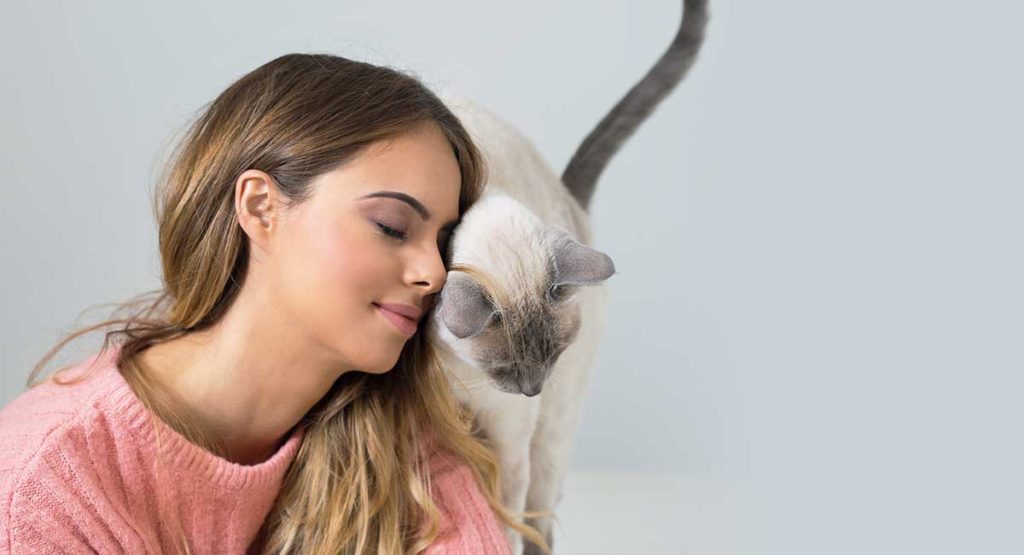
Many pet owners may think that cat head pressing is a commonly seen cat behavior. After all, cats seem to use their heads the way we use our hands! They engage in head bumping, head rubbing, and even a simple cat head press.
But the truth is that true cat head pressing has much more serious connotations. So it is important that we understand the difference between a cat head pressing and head bumping.
Our felines are enigmatic creatures, so we often wonder if behaviors like this mean something. What is behind head pressing in cats? And what should we watch for in the behavior of head pressing cats?
Our Favorite Felines
Throughout the ages, cats have been described as enigmatic, aloof creatures.
Perhaps this is one of the reasons why we’re so addicted to watching videos of them losing their dignity. There’s nothing quite as adorable as seeing a cat falling off things or jumping at the sight of a cucumber!
However, for many of us it’s their air of mystery that makes them such attractive pets. Cats are worthy of a life-long study in order to try and decipher their language and the physical cues they give us!
We love the fact that, much of the time, we’re not quite sure what they’re feeling or why they’re doing what they’re doing.
This is why we relish the moments when our cats drop their guard and show us that they really are rather fond of us.
Head Pressing Cats And Affection
One of the ways they might choose to do this is by pressing or rubbing their forehead or cheeks against our legs, hands, or even our faces.
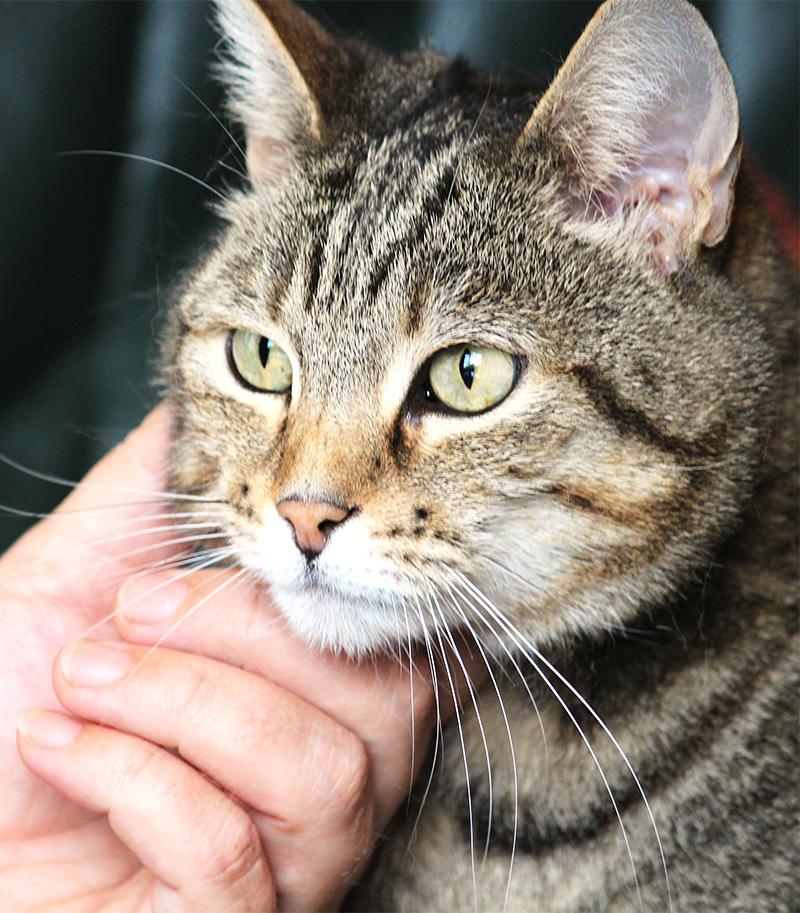
This is not only a lovely, positive sign of their willingness to interact with us. It also allows them to deposit their scent on us, which helps to reinforce their perception of safety in their own environment.
While we might think that this is one of the easier to interpret expressions of cat behavior, the complex nature of our family felines means that it’s entirely possible for us to confuse it with another behavior.
In fact, this other behavior is something much more serious, and it is commonly called “head pressing.” Head pressing is very different from head rubbing, but there are enough similarities that cat owners should be fully aware of which one they are dealing with.
So let’s take a look at both head rubbing and head pressing in cats to help us identify the differences between them. This will help us to understand when we need to take action.
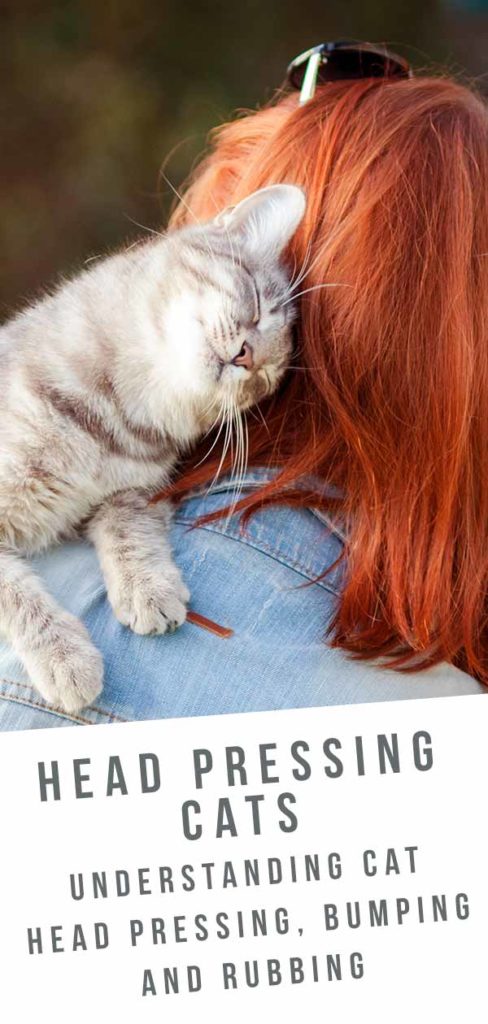
What Is Head Pressing In Cats?
So what exactly is head pressing in cats?
Head pressing in dogs and cats is one of a number of specific behaviors performed as a result of an underlying neurological disorder or central nervous system problem.
The specific causes of the behavior may include:
- brain tumors
- liver shunts (where the blood flow to and through the liver is compromised)
- damage to the forebrain and thalamus
- stroke
- toxic poisoning
- metabolic disorder
- inflammation of the brain (caused by bacteria, viruses, parasites, or fungus)
- infection of the nervous system (such as rabies, parasites, bacterial, viral or fungal infection)
- liver disease
- head trauma
All of these are potentially life threatening conditions. So the sooner we can identify cats head pressing as abnormal behavior the better.
What Do Cats Head Pressing Look Like?
The important thing about identifying any medical condition is identifying your own cat’s normal behavior versus what’s unusual.
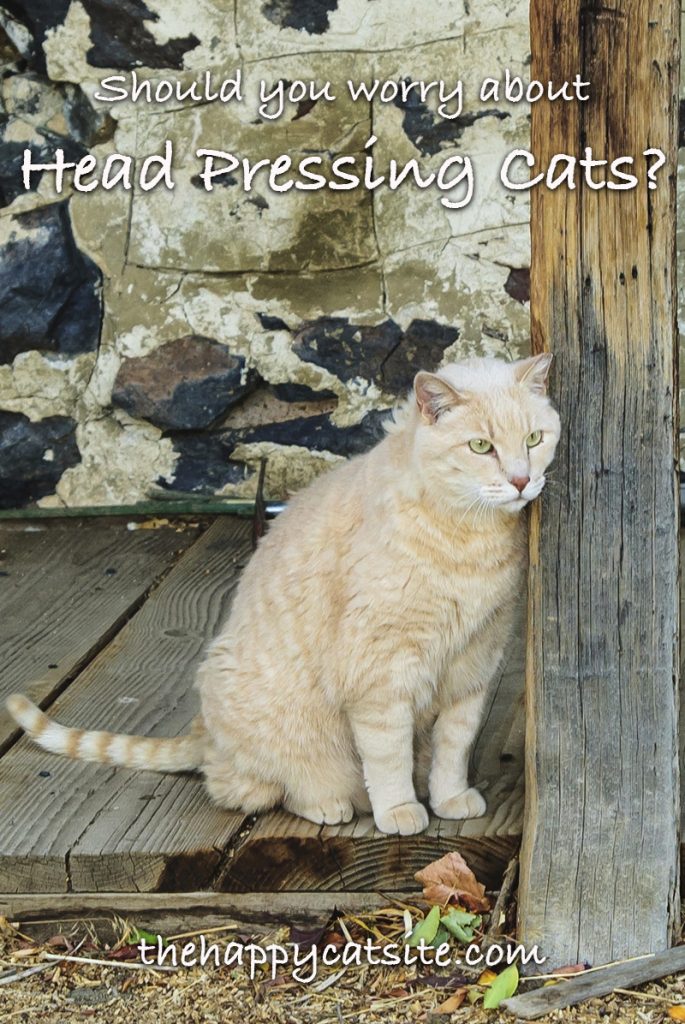
This is especially important for conditions where the symptoms may closely resemble a normal feline behavior.
A head pressing cat will persistently press his head against a solid surface for no apparent reason and for extended periods of time.
If the object is moveable, the pressure of the cat’s head against it may be enough to force the object towards the nearest wall or corner. This can lead to the cat getting ‘stuck’, unable to go any further.
How To Identify Cat Head Pressing
If you are unsure whether the behavior that your cat is displaying is actually “cat head pressing,” there are a few questions to ask yourself.
- Is it a new behavior?
- Is it persistent, lasting longer than a minute or so?
When in doubt, it is always recommended to check with your vet.
Beforehand, of course, you can do a quick Google search and find photos of “cat head pressing” to give you an idea of what it looks like, and what it doesn’t.
Along with that help, there are some other signs and symptoms to watch out for.
Head Pressing Cats Symptoms
Head pressing in cats may be accompanied by other symptoms, including:
- staring into space
- walking in circles
- pacing
- loss of balance
- general disorientation
- depression
- problems with vision
- abnormal vocalization
- head tilt
- head tremors
- lethargy
- loss of appetite
- weight loss
- seizures
Confusingly, head pressing in cats be mistaken for more than just innate feline head rubbing behavior. It can be also be a behavior performed by cats that develop age-related cognitive impairment known as Cognitive Dysfunction Syndrome.
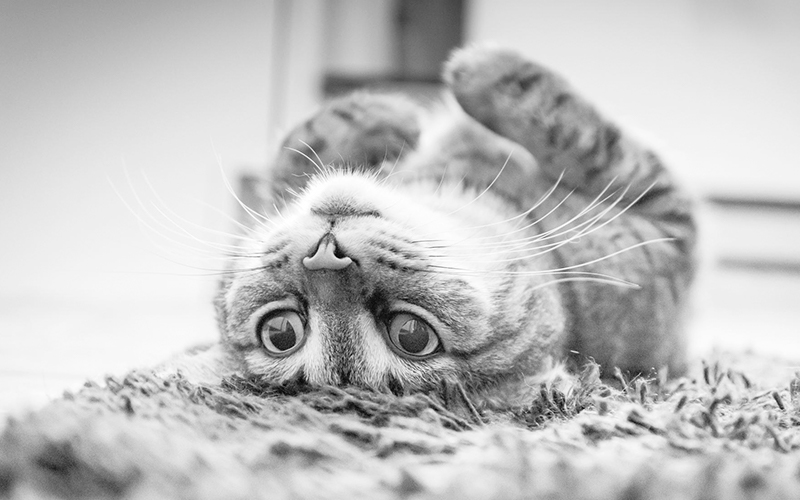
Head Pressing Cats And CDS
Cognitive Dysfunction Syndrome is a condition similar to Alzheimer’s in humans. It is recognized primarily in cats over 12 years of age, but can affect cats from as early as 7 years old. Symptoms of CDS include:
- becoming lost in previously familiar environments
- aimless wandering (often pacing at night)
- difficulty navigating the stairs
- general disorientation
Owners might notice their cat walking towards household objects and appear not to know how to maneuver around them.
A cat might walk into a corner and be unable to turn around. At a loss for what else to do, the cat may press his head against the wall or in the corner.
Obviously, this may appear like a behavior that could easily be described as “cat head pressing.” But, again, there is much more behind it than a simple behavior, and a visit to the vet is necessary.
What To Do If Your Cat Is Head Pressing
So, you can see why identifying the reasons for cat head pressing behavior can be a tricky business.
However, the bottom line is this. If your cat is displaying any of the above symptoms, don’t wait and try to figure it out on your own. It is vital that you get veterinary help immediately. Depending on the nature and severity of the symptoms, your veterinarian may then refer your cat to a neurological specialist.
One final note about head pressing cats is that the behavior shouldn’t be confused with what occasionally appears to be a cat head pressing while sleeping. A cat head pressing while sleeping is much more likely to be a great deal less worrisome.
Some cats naturally like to sleep with their head down or tucked against the side of an armchair or their bed, and they look all the sweeter for it.
Cat head rubbing, meanwhile, is a completely different thing. So let’s take a look at that next.
Why Do Cats Rub Their Heads On Things?
Even though cat behavior can sometimes be difficult to read, cats do in fact have a lot of communication signals.
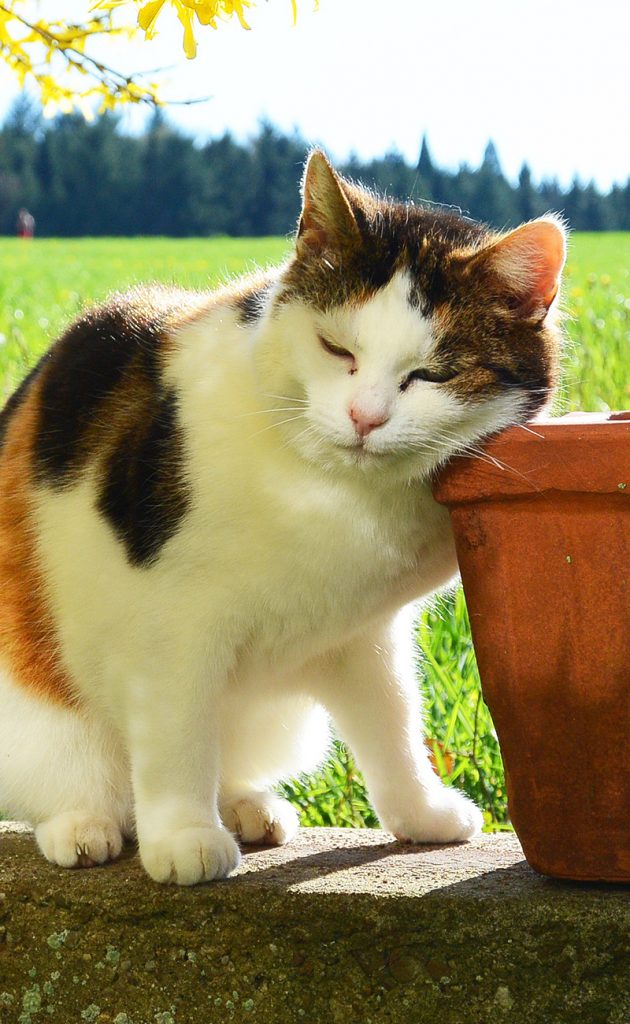
Among these are the head butting and cheek rubbing behaviors that we so much enjoy watching, but don’t necessarily fully understand! What we do know is that there are a number of glands on cats’ bodies that produce fatty secretions.
The locations of these glands include the corners of their lips, under their chin and on each side their forehead. All these areas are only lightly covered with fur.
When cats head bump you, or rub their cheeks on a piece of furniture, what they are doing is depositing scent from these glands.
The scent, known as pheromones, contains chemical information to help cats evaluate their surroundings. It can also maximize their sense of security within the environment and solicit attention.
Specific Areas For Head Rubbing
Your cat may tend to rub one area more than others. And there seem to be “keys” behind those choices as well.
It’s thought that the action of head rubbing is associated more with social interaction with people and other cats.
On the other hand, rubbing with the cheeks, chin, and lips may be used more as a means of marking inanimate objects in and around the house.
All in all, seeing a cat rubbing its head is a common sight, and if it is only that, it is no cause for alarm.
Why Do Cats Head Bump You?
Cat head butting, also known head bunting, head bumping, or head rubbing, is a behavior associated with a positive emotional state.
It may be performed by your cat as a sign of familiarity. For example, he may use it as a way to greet you when you’ve been out at work or when you let him in after he’s been out hunting in the garden.
In fact, adult cats perform head rubs on people in a very similar manner to the way they rub other cats. So, if you respond by stroking or scratching them around the head, you are ‘grooming’ them just as another cat might do!
It’s no wonder, then, that cats respond best to us when we stroke them in these areas. You’re likely to get a much better reaction here as opposed to stroking them on other areas of the body, such as the back and tummy, which might lead to a more confrontational response!
It’s also worth bearing in mind that some cats might not want any stroking at all in response to a head butt. So it’s important that you understand your cat’s individual preferences when it comes to physical interaction. It could just be their way of saying, “Hey.”
A Normal Human Reaction To Cat Head Bumping
You also need to be careful that you don’t misinterpret your cat’s head butting as a sign that he’s hungry and wants food.
If you do offer your cat a tasty morsel, you’ll be rewarding him for the behavior, and he’ll soon learn that he can control when you give him food simply by head butting you!
Of course, when our cats do something affectionate or to get our attention, we often want to respond in kind. So stroking your cat or bumping him gently back may be the best choice.
Why Do Cats Rub Their Cheeks on Things?
It is believed that cats rub their facial areas on items as a means of ‘marking’ them.
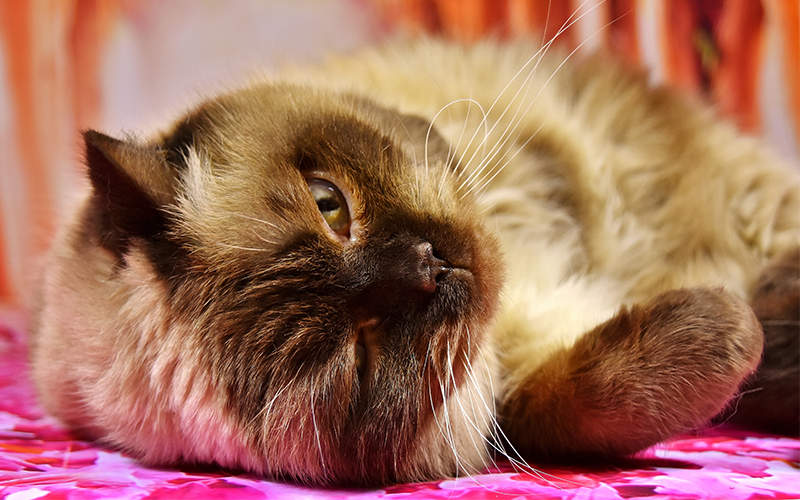
As described above, cats have scent glands around their face. When they rub their cheeks, chin, and lips on an object, they are transferring secretions from the glands onto the object.
This allows them to spread their scent around their core environment. It helps them to feel safe and secure which in turn can help reduce their levels of stress and anxiety.
The information left by the scent not only serves to reassure your cat, but is also a means of chemical communication with any other cats in the environment.
Research is still ongoing as to what the exact nature of these chemicals are and what messages they’re sending out.
Rubbing Pattern
When a cat facial rubs, he’ll usually start at the corner of his mouth and rub in the direction of his whiskers.
You may see him closing his eyes as he does this. He may rub the same area several times in succession and use alternate cheeks.
The objects he chooses to cheek rub will usually be the corner edges of walls, doors and furniture, as well as fences and gates outside the home.
He will usually return to these areas each time he performs the behavior.
Head Pressing Cats
Hopefully this will help you identify the differences between normal feline head rubbing and the potentially much more serious compulsive head pressing behavior.
The key thing to remember is to ask yourself “Is this a new behavior? Or is it different to anything I’ve seen my cat do before?”
If the answer is the latter, then it’s time to get your cat checked out by a vet.
References And Further Reading
- Feline Intracranial Neoplasia: Retrospective Review of 160 Cases (1985–2001)
- A Practical Guide to Canine and Feline Neurology edited by Curtis W. Dewey
- Cognitive Dysfunction Syndrome in Companion Animals: Diagnosis and Treatment. Amy L. Pike, DVM, DACVB
- Chemical Communication. Dr Sarah Ellis and Helen Zulch, University of Lincoln
- Bradshaw and Cook 1996 Cat sociability towards humans
- Comparison of stress exhibited by cats, Applied Animal Behaviour Science, 2015
This article has been updated and revised for 2019.
Very interesting article! My cat does a lot of head bumping, so I suppose he must like us a little bit!
None of our cats rub against furniture etc. They do like to get their cheeks and ears rubbed but us though. I was always wondering if not giving their scent to their surroundings was normal. They don’t scratch the furniture either, thank goodness. We do have quite a lot of scratching material for the cats around the house and they do use that a lot, so perhaps that’s enough to give their scent to places?
Should I be worried our cats are not rubbing to the doors etc like others do?